2006 FORD MONDEO brake
[x] Cancel search: brakePage 5 of 198
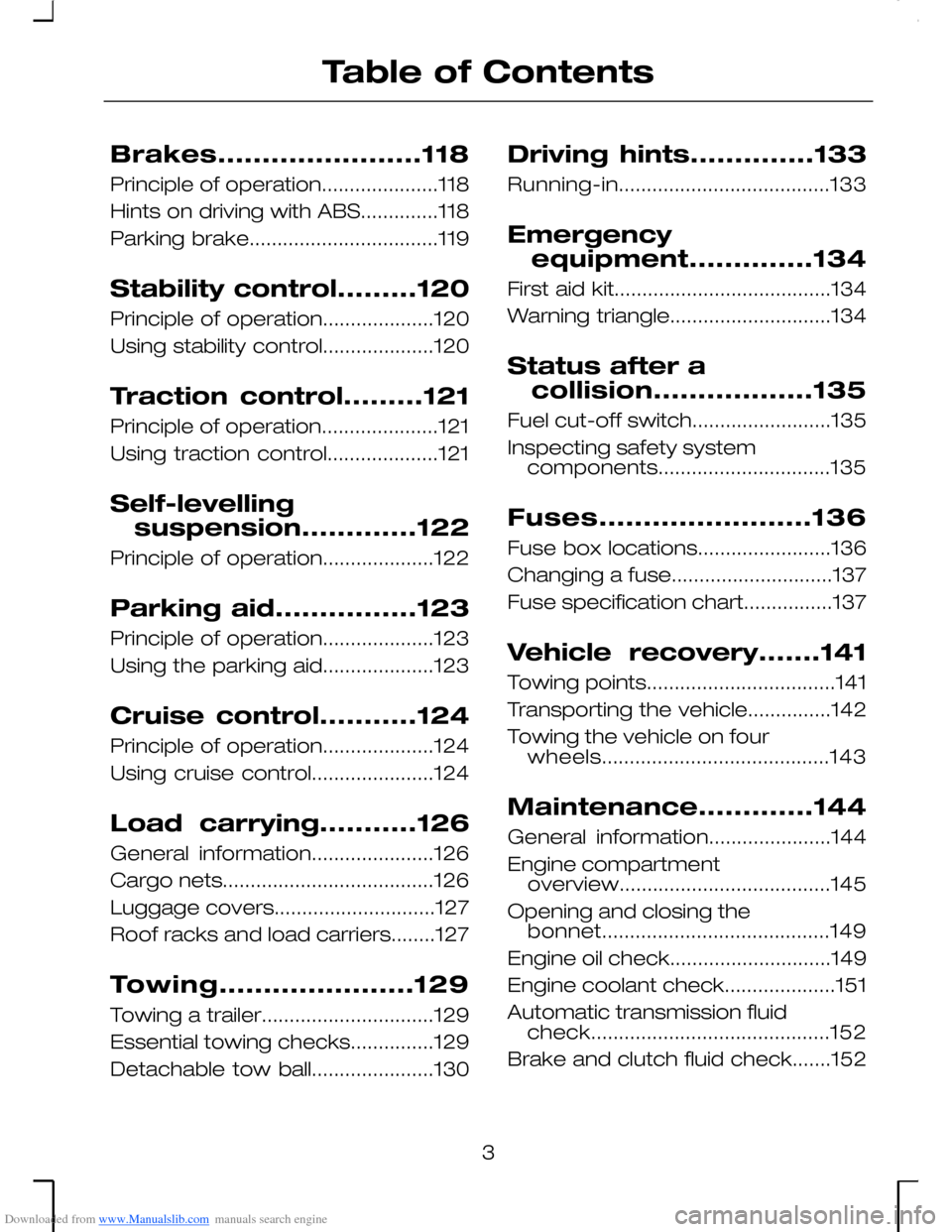
Downloaded from www.Manualslib.com manuals search engine Brakes.......................118
Principle of operation.....................118
Hints on driving with ABS..............118
Parking brake..................................119
Stability control.........120
Principle of operation....................120
Using stability control....................120
Traction control.........121
Principle of operation.....................121
Using traction control....................121
Self-levelling
suspension.............122
Principle of operation....................122
Parking aid................123
Principle of operation....................123
Using the parking aid....................123
Cruise control...........124
Principle of operation....................124
Using cruise control......................124
Load carrying...........126
General information......................126
Cargo nets......................................126
Luggage covers.............................127
Roof racks and load carriers........127
Towing......................129
Towing a trailer...............................129
Essential towing checks...............129
Detachable tow ball......................130
Driving hints..............133
Running-in......................................133
Emergency
equipment..............134
First aid kit.......................................134
Warning triangle.............................134
Status after a
collision..................135
Fuel cut-off switch.........................135
Inspecting safety systemcomponents...............................135
Fuses........................136
Fuse box locations........................136
Changing a fuse.............................137
Fuse specification chart................137
Vehicle recovery.......141
Towing points..................................141
Transporting the vehicle...............142
Towing the vehicle on fourwheels.........................................143
Maintenance.............144
General information......................144
Engine compartmentoverview......................................145
Opening and closing thebonnet.........................................149
Engine oil check.............................149
Engine coolant check....................151
Automatic transmission fluidcheck...........................................152
Brake and clutch fluid check.......152
3
Table of Contents
Page 12 of 198
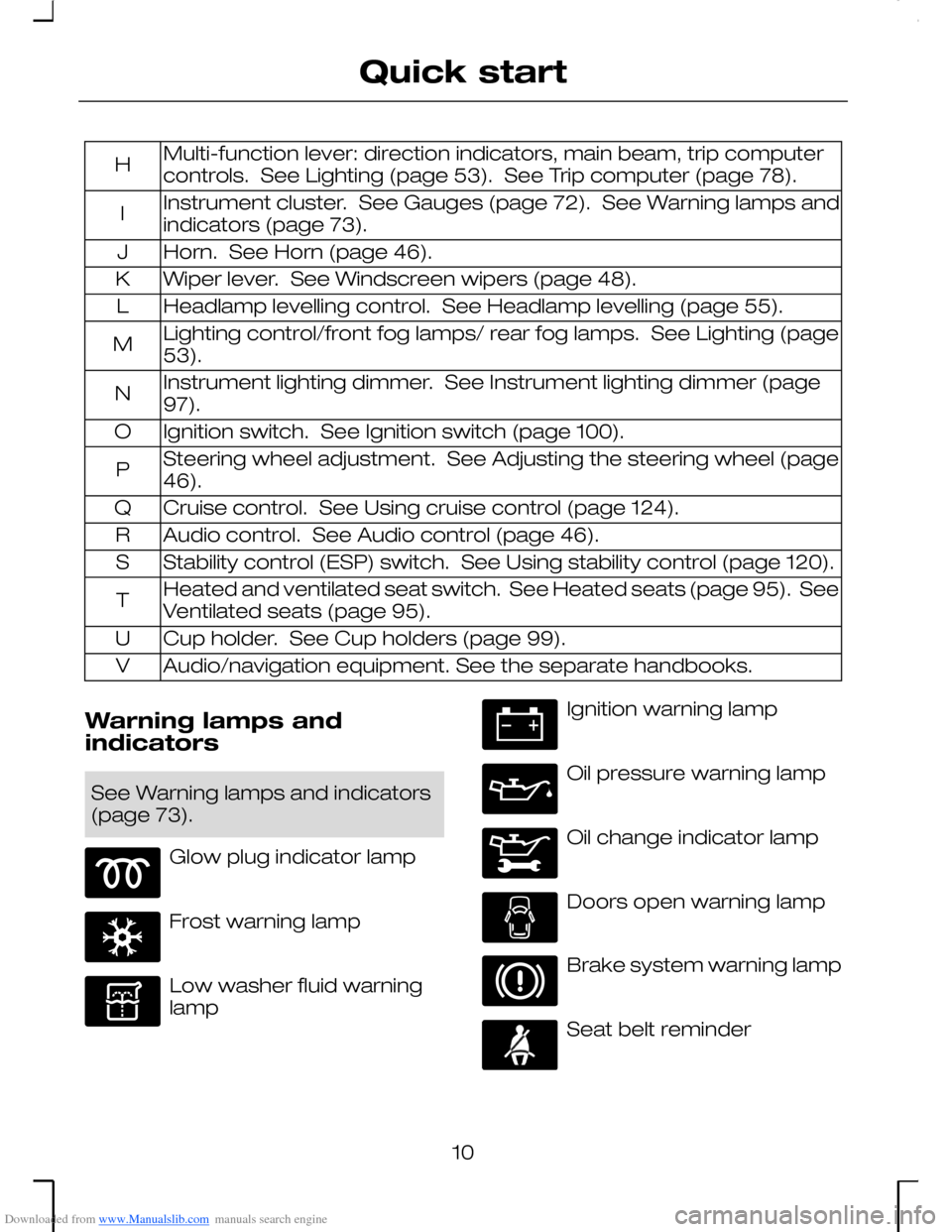
Downloaded from www.Manualslib.com manuals search engine Multi-function lever: direction indicators, main beam, trip computercontrols. See Lighting (page 53). See Trip computer (page 78).H
Instrument cluster. See Gauges (page 72). See Warning lamps andindicators (page 73).I
Horn. See Horn (page 46).J
Wiper lever. See Windscreen wipers (page 48).K
Headlamp levelling control. See Headlamp levelling (page 55).L
Lighting control/front fog lamps/ rear fog lamps. See Lighting (page53).M
Instrument lighting dimmer. See Instrument lighting dimmer (page97).N
Ignition switch. See Ignition switch (page 100).O
Steering wheel adjustment. See Adjusting the steering wheel (page46).P
Cruise control. See Using cruise control (page 124).Q
Audio control. See Audio control (page 46).R
Stability control (ESP) switch. See Using stability control (page 120).S
Heated and ventilated seat switch. See Heated seats (page 95). SeeVentilated seats (page 95).T
Cup holder. See Cup holders (page 99).U
Audio/navigation equipment. See the separate handbooks.V
Warning lamps andindicators
See Warning lamps and indicators(page 73).
Glow plug indicator lamp
Frost warning lamp
Low washer fluid warninglamp
Ignition warning lamp
Oil pressure warning lamp
Oil change indicator lamp
Doors open warning lamp
Brake system warning lamp
Seat belt reminder
10
Quick start
Page 64 of 198
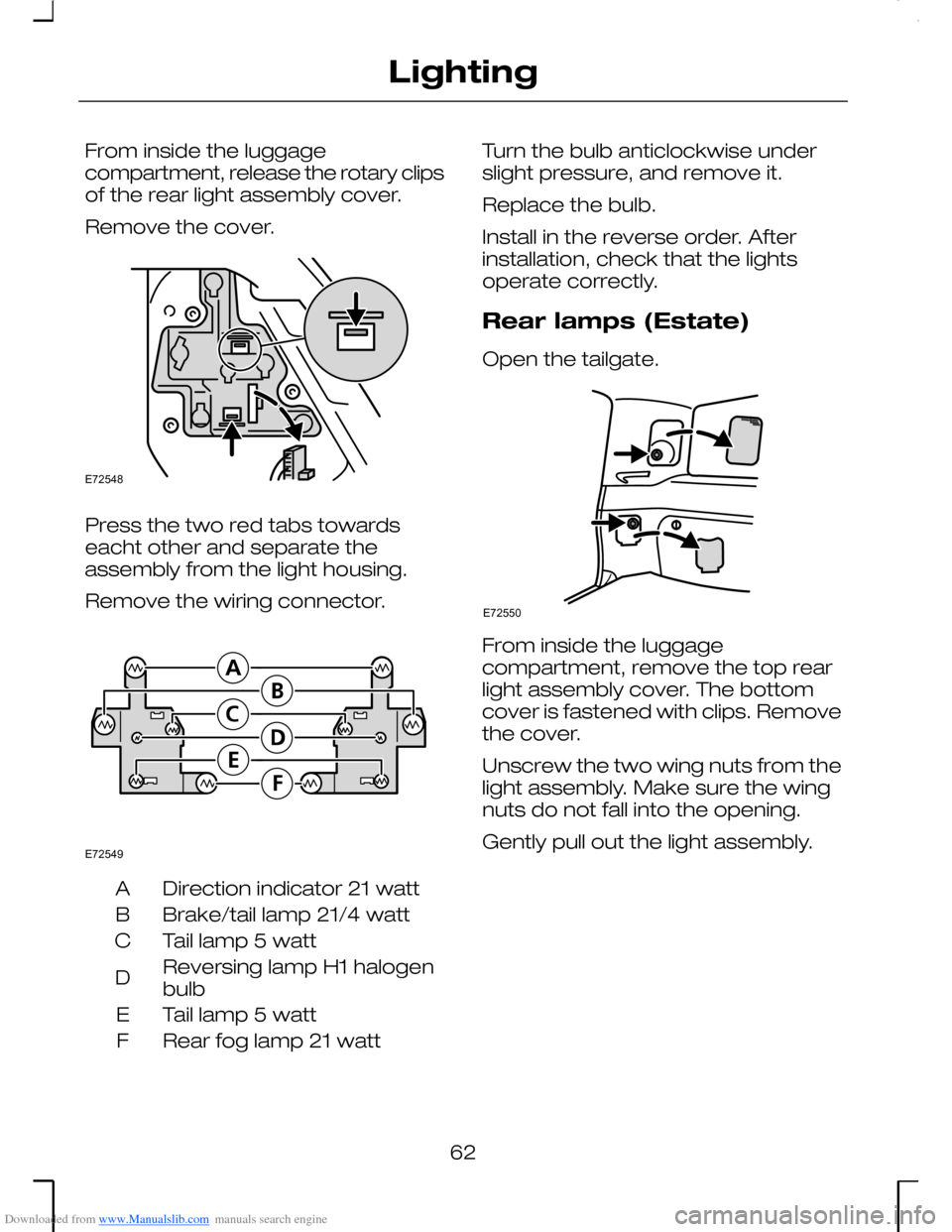
Downloaded from www.Manualslib.com manuals search engine From inside the luggagecompartment, release the rotary clipsof the rear light assembly cover.
Remove the cover.
Press the two red tabs towardseacht other and separate theassembly from the light housing.
Remove the wiring connector.
Direction indicator 21 wattA
Brake/tail lamp 21/4 wattB
Tail lamp 5 wattC
Reversing lamp H1 halogenbulbD
Tail lamp 5 wattE
Rear fog lamp 21 wattF
Turn the bulb anticlockwise underslight pressure, and remove it.
Replace the bulb.
Install in the reverse order. Afterinstallation, check that the lightsoperate correctly.
Rear lamps (Estate)
Open the tailgate.
From inside the luggagecompartment, remove the top rearlight assembly cover. The bottomcover is fastened with clips. Removethe cover.
Unscrew the two wing nuts from thelight assembly. Make sure the wingnuts do not fall into the opening.
Gently pull out the light assembly.
62
LightingE72548 E72549 E72550
Page 65 of 198
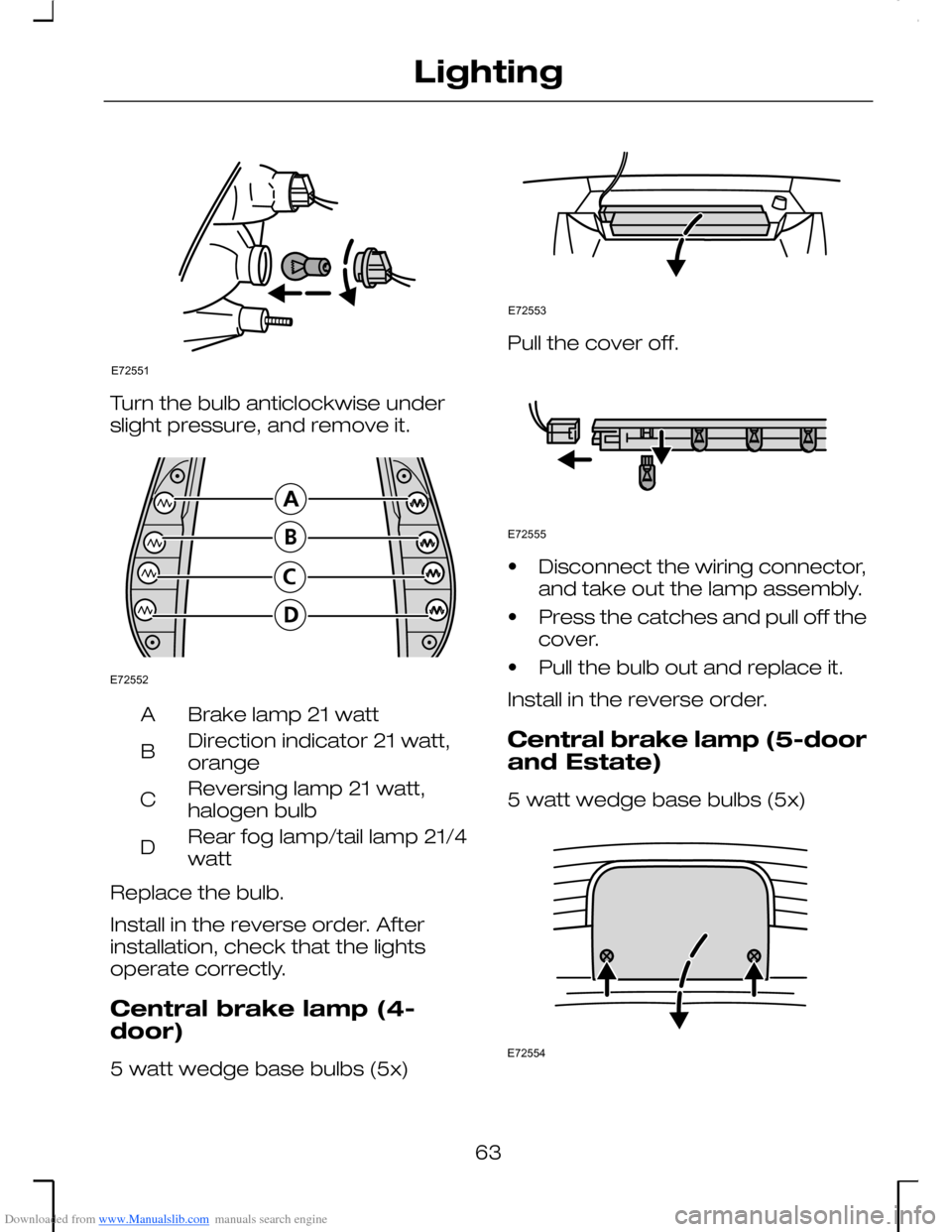
Downloaded from www.Manualslib.com manuals search engine Turn the bulb anticlockwise underslight pressure, and remove it.
Brake lamp 21 wattA
Direction indicator 21 watt,orangeB
Reversing lamp 21 watt,halogen bulbC
Rear fog lamp/tail lamp 21/4wattD
Replace the bulb.
Install in the reverse order. Afterinstallation, check that the lightsoperate correctly.
Central brake lamp (4-door)
5 watt wedge base bulbs (5x)
Pull the cover off.
•Disconnect the wiring connector,and take out the lamp assembly.
•Press the catches and pull off thecover.
•Pull the bulb out and replace it.
Install in the reverse order.
Central brake lamp (5-doorand Estate)
5 watt wedge base bulbs (5x)
63
LightingE72551 E72552 E72553 E72555 E72554
Page 75 of 198
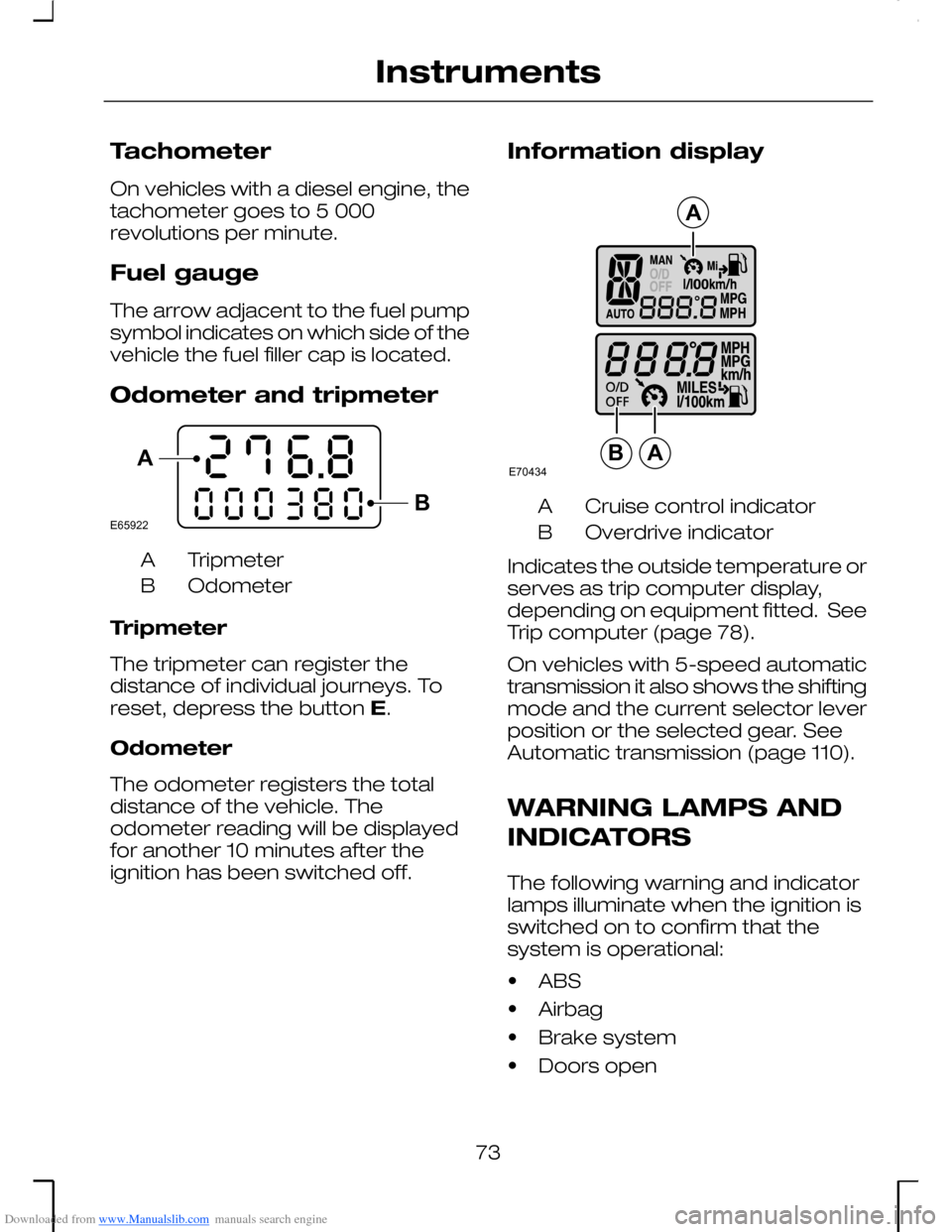
Downloaded from www.Manualslib.com manuals search engine Tachometer
On vehicles with a diesel engine, thetachometer goes to 5 000revolutions per minute.
Fuel gauge
The arrow adjacent to the fuel pumpsymbol indicates on which side of thevehicle the fuel filler cap is located.
Odometer and tripmeter
TripmeterA
OdometerB
Tripmeter
The tripmeter can register thedistance of individual journeys. Toreset, depress the button E.
Odometer
The odometer registers the totaldistance of the vehicle. Theodometer reading will be displayedfor another 10 minutes after theignition has been switched off.
Information display
Cruise control indicatorA
Overdrive indicatorB
Indicates the outside temperature orserves as trip computer display,depending on equipment fitted. SeeTrip computer (page 78).
On vehicles with 5-speed automatictransmission it also shows the shiftingmode and the current selector leverposition or the selected gear. SeeAutomatic transmission (page 110).
WARNING LAMPS AND
INDICATORS
The following warning and indicatorlamps illuminate when the ignition isswitched on to confirm that thesystem is operational:
•ABS
•Airbag
•Brake system
•Doors open
73
InstrumentsE65922BA AABE70434
Page 76 of 198
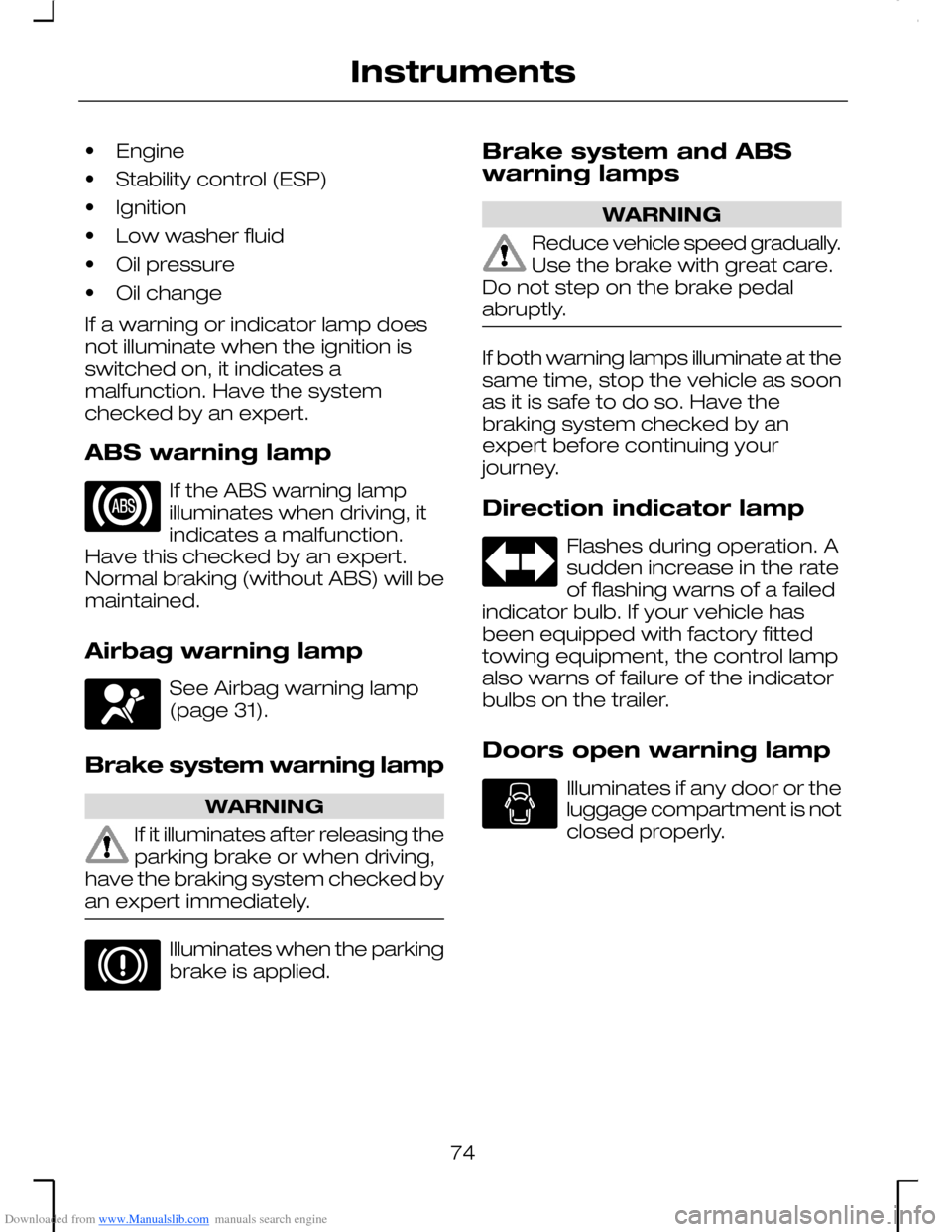
Downloaded from www.Manualslib.com manuals search engine •Engine
•Stability control (ESP)
•Ignition
•Low washer fluid
•Oil pressure
•Oil change
If a warning or indicator lamp doesnot illuminate when the ignition isswitched on, it indicates amalfunction. Have the systemchecked by an expert.
ABS warning lamp
If the ABS warning lampilluminates when driving, itindicates a malfunction.Have this checked by an expert.Normal braking (without ABS) will bemaintained.
Airbag warning lamp
See Airbag warning lamp(page 31).
Brake system warning lamp
WARNING
If it illuminates after releasing theparking brake or when driving,have the braking system checked byan expert immediately.
Illuminates when the parkingbrake is applied.
Brake system and ABSwarning lamps
WARNING
Reduce vehicle speed gradually.Use the brake with great care.Do not step on the brake pedalabruptly.
If both warning lamps illuminate at thesame time, stop the vehicle as soonas it is safe to do so. Have thebraking system checked by anexpert before continuing yourjourney.
Direction indicator lamp
Flashes during operation. Asudden increase in the rateof flashing warns of a failedindicator bulb. If your vehicle hasbeen equipped with factory fittedtowing equipment, the control lampalso warns of failure of the indicatorbulbs on the trailer.
Doors open warning lamp
Illuminates if any door or theluggage compartment is notclosed properly.
74
Instruments
Page 112 of 198
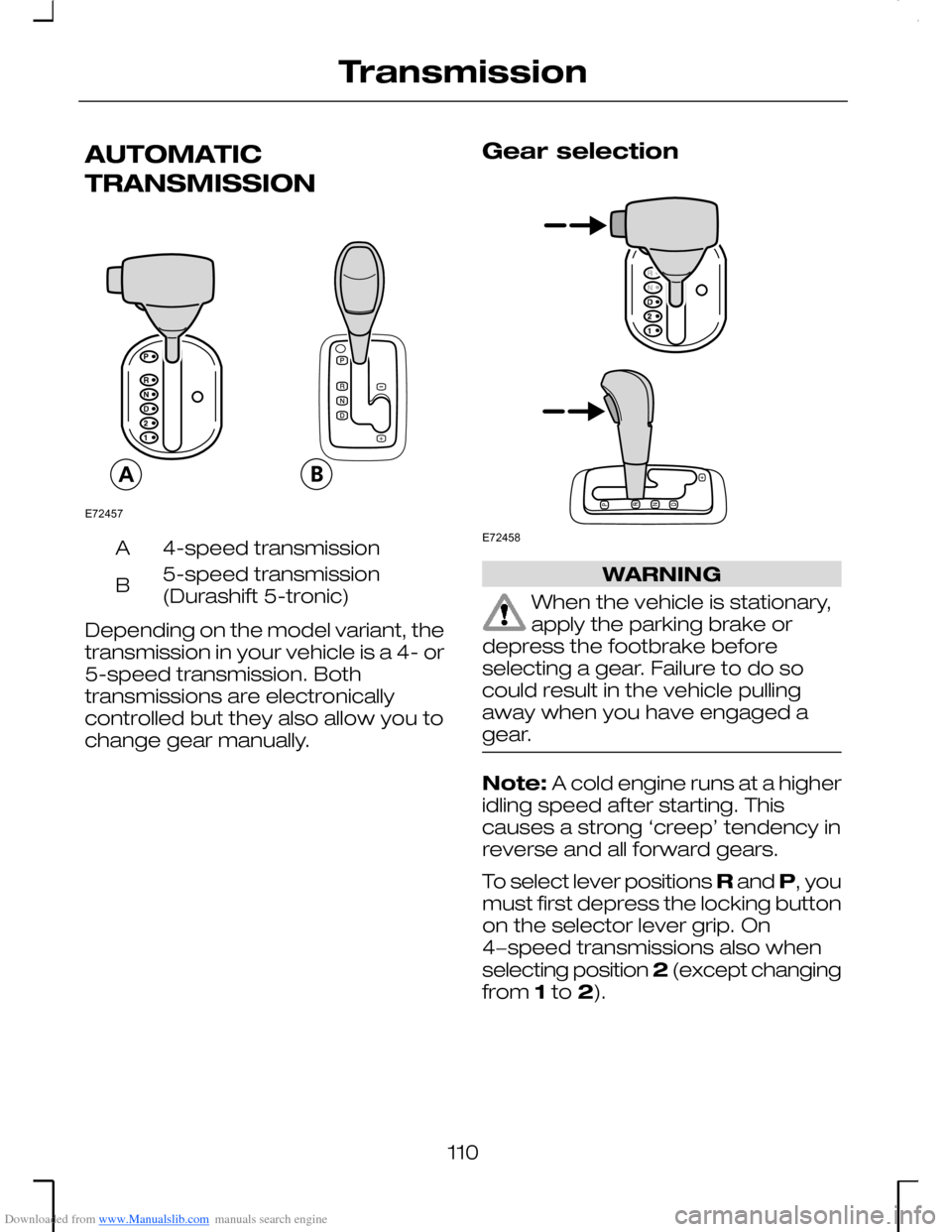
Downloaded from www.Manualslib.com manuals search engine AUTOMATIC
TRANSMISSION
4-speed transmissionA
5-speed transmission(Durashift 5-tronic)B
Depending on the model variant, thetransmission in your vehicle is a 4- or5-speed transmission. Bothtransmissions are electronicallycontrolled but they also allow you tochange gear manually.
Gear selection
WARNING
When the vehicle is stationary,apply the parking brake ordepress the footbrake beforeselecting a gear. Failure to do socould result in the vehicle pullingaway when you have engaged agear.
Note: A cold engine runs at a higheridling speed after starting. Thiscauses a strong ‘creep’ tendency inreverse and all forward gears.
To select lever positions R and P, youmust first depress the locking buttonon the selector lever grip. On4−speed transmissions also whenselecting position 2 (except changingfrom 1 to 2).
110
TransmissionE72457 E72458
Page 113 of 198
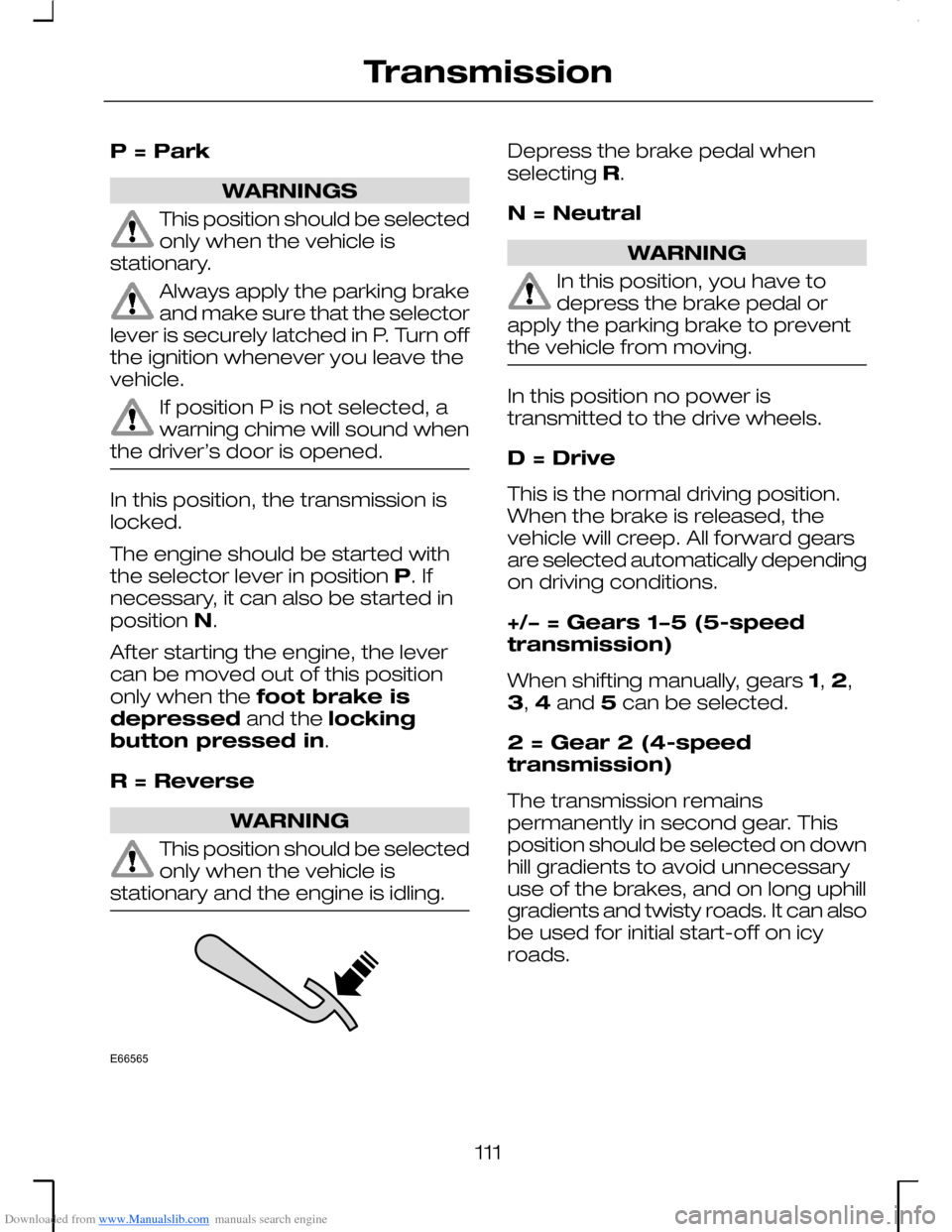
Downloaded from www.Manualslib.com manuals search engine P = Park
WARNINGS
This position should be selectedonly when the vehicle isstationary.
Always apply the parking brakeand make sure that the selectorlever is securely latched in P. Turn offthe ignition whenever you leave thevehicle.
If position P is not selected, awarning chime will sound whenthe driver’s door is opened.
In this position, the transmission islocked.
The engine should be started withthe selector lever in position P. Ifnecessary, it can also be started inposition N.
After starting the engine, the levercan be moved out of this positiononly when the foot brake isdepressed and the lockingbutton pressed in.
R = Reverse
WARNING
This position should be selectedonly when the vehicle isstationary and the engine is idling.
Depress the brake pedal whenselecting R.
N = Neutral
WARNING
In this position, you have todepress the brake pedal orapply the parking brake to preventthe vehicle from moving.
In this position no power istransmitted to the drive wheels.
D = Drive
This is the normal driving position.When the brake is released, thevehicle will creep. All forward gearsare selected automatically dependingon driving conditions.
+/− = Gears 1−5 (5-speedtransmission)
When shifting manually, gears 1, 2,3, 4 and 5 can be selected.
2 = Gear 2 (4-speedtransmission)
The transmission remainspermanently in second gear. Thisposition should be selected on downhill gradients to avoid unnecessaryuse of the brakes, and on long uphillgradients and twisty roads. It can alsobe used for initial start-off on icyroads.
111
TransmissionE66565